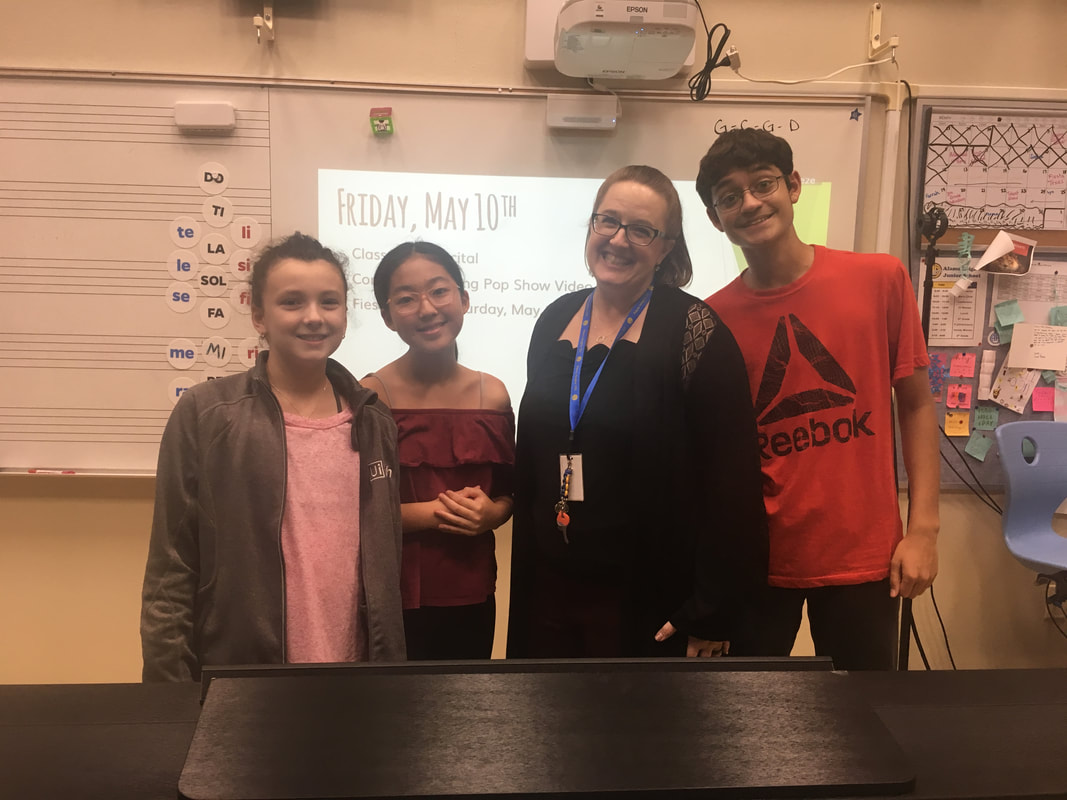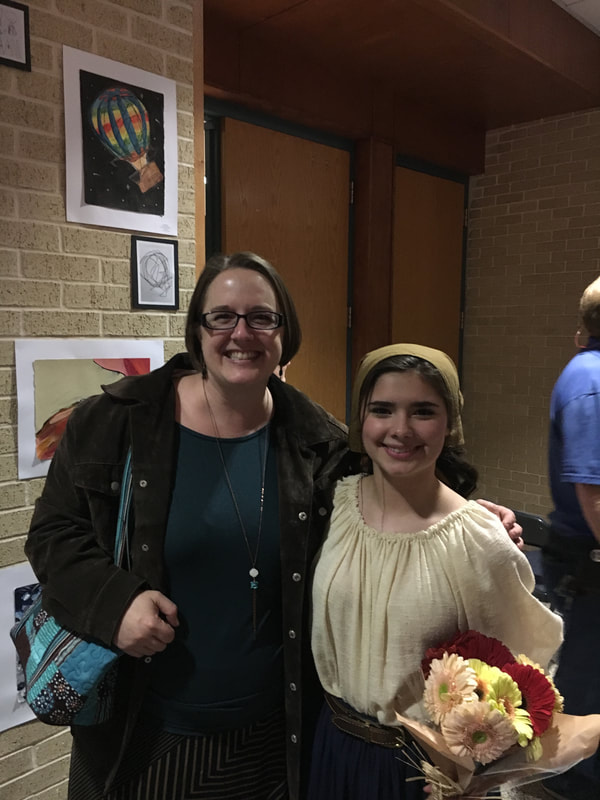Click the link below to open my TMEA 2020-21 Google Drive folder with a key signature guide for all the songs and my PDFs of the music. Conductor’s notes taken from TMEA.org are notated in deep blue. Key changes are written in green. Solfege is written in bright blue. Measure numbers are in black.
Amid school closures...
|
Well, here we go—into an unknown realm. Are you ready? It took some inspiration from colleagues and some outside-the-box thinking, but after the initial shock of school closures, I am re-energized about continuing voice lessons in a unique way. I’m still sussing out the details, but here are a few ways we can keep voice lessons going!
1. Online lessons through FaceTime or Skype. Easy to coordinate, will provide a few challenges due to signal delay, but will force the students to be more independent and listen to themselves more, and force me to watch and listen to them more (as opposed to me playing the piano more during in-person lessons). I would be able to play the warm-ups with them, to a certain extent. I’ll have to compensate for lag time, or have them sing a cappella. When learning songs, they would be looking at a printed PDF of their music and making notes there, including solfege, breathing, vowels, etc. We would learn it together just like we always do, with back-and-forth singing. When they are to the point where they are ready to sing it through, I would provide recordings for them to sing with during the lesson. All they would need is their phone for making the video call, a quiet space, and another device to play the recording on—not totally necessary for all students depending on the stage they are at learning their music, but it will be helpful if this continues for more than a few weeks. (I’m also open to suggestions about other online platforms if you have experience with this type of thing!)
2. Asynchronistic instruction. For students without video call capabilities. Depending on what the student is currently working on in lessons, this can look like a variety of things. The time we would’ve spent in a 23-minute lesson can be spent in these ways:
a) For students who are still selecting their next song to learn—I would pre-select and send a list of repertoire choices and PDF files for them to choose from, along with recordings to listen to or YouTube links to watch. They would send me their responses to those choices, either written or recorded.
b) For students with new songs that they are just starting to learn—I would send written or recorded instructions for the student to solfege their song, along with recordings to help them start learning it. They would send a picture or scan of their solfeged music back to me, along with a recording of them practicing it.
c) For students who are already in the process of learning their songs—Students would make recordings of themselves singing with a practice track, which I would watch/listen to and send back written or recorded feedback and instruction. They can also watch the recordings and write self-evaluations. (This is my personal favorite for them to do!)
d) For students wanting to work on music theory or IPA, I can send worksheets, charts, and practice drills. They would send them back to me completed.
e) Other creative ideas that students may have!
Option #1 is more like what we currently do.
Option #2 would take more time and might account for a few lessons on one activity, but it could be done any time without having to schedule it. It wouldn’t look like a typical voice lesson, but making recordings, doing self-evaluations, and focusing on the written aspects of music are all good ways to learn!
Both of these options will pose challenges for us, but will also give us a new perspective and make us aware of things we haven’t noticed before. In online lessons, the teacher tends to listen more and talk or sing less. More of the responsibility for success falls on the student. I’m up for the challenge. Patience and a desire to learn will make it work!
1. Online lessons through FaceTime or Skype. Easy to coordinate, will provide a few challenges due to signal delay, but will force the students to be more independent and listen to themselves more, and force me to watch and listen to them more (as opposed to me playing the piano more during in-person lessons). I would be able to play the warm-ups with them, to a certain extent. I’ll have to compensate for lag time, or have them sing a cappella. When learning songs, they would be looking at a printed PDF of their music and making notes there, including solfege, breathing, vowels, etc. We would learn it together just like we always do, with back-and-forth singing. When they are to the point where they are ready to sing it through, I would provide recordings for them to sing with during the lesson. All they would need is their phone for making the video call, a quiet space, and another device to play the recording on—not totally necessary for all students depending on the stage they are at learning their music, but it will be helpful if this continues for more than a few weeks. (I’m also open to suggestions about other online platforms if you have experience with this type of thing!)
2. Asynchronistic instruction. For students without video call capabilities. Depending on what the student is currently working on in lessons, this can look like a variety of things. The time we would’ve spent in a 23-minute lesson can be spent in these ways:
a) For students who are still selecting their next song to learn—I would pre-select and send a list of repertoire choices and PDF files for them to choose from, along with recordings to listen to or YouTube links to watch. They would send me their responses to those choices, either written or recorded.
b) For students with new songs that they are just starting to learn—I would send written or recorded instructions for the student to solfege their song, along with recordings to help them start learning it. They would send a picture or scan of their solfeged music back to me, along with a recording of them practicing it.
c) For students who are already in the process of learning their songs—Students would make recordings of themselves singing with a practice track, which I would watch/listen to and send back written or recorded feedback and instruction. They can also watch the recordings and write self-evaluations. (This is my personal favorite for them to do!)
d) For students wanting to work on music theory or IPA, I can send worksheets, charts, and practice drills. They would send them back to me completed.
e) Other creative ideas that students may have!
Option #1 is more like what we currently do.
Option #2 would take more time and might account for a few lessons on one activity, but it could be done any time without having to schedule it. It wouldn’t look like a typical voice lesson, but making recordings, doing self-evaluations, and focusing on the written aspects of music are all good ways to learn!
Both of these options will pose challenges for us, but will also give us a new perspective and make us aware of things we haven’t noticed before. In online lessons, the teacher tends to listen more and talk or sing less. More of the responsibility for success falls on the student. I’m up for the challenge. Patience and a desire to learn will make it work!
|
In voice lessons, students will:
•Discover strengths/weaknesses •Gain confidence •Extend range •Improve tone •Increase breath support •Learn to read music •Practice sightreading skills •Work through voice changes •Prepare for Region/Area/All-State auditions •Participate in Solo & Ensemble competitions •Perform in end-of-semester recitals |
Voice students are expected to:
•Commit to lessons for the entire school year •Bring materials to lessons (music, pencil, water) •Attend lessons every week •Practice between lessons •Be respectful and willing to learn •Meet payment deadlines •Notify teacher of schedule changes •Take care of their vocal health |
Pay through Venmo
(requires Venmo app on phone)
Suzie RochaSuzie Rocha, soprano, is returning as voice teacher for the 2020-21 school year at Alamo Heights High School and Junior School. She earned her bachelor’s degree in Music Education in 1998, and her Master’s Degree in Vocal Pedagogy and Performance in 2012—both at UTSA. For over 24 years, she has taught private voice lessons, and directed and accompanied choirs at middle schools, high schools, and churches. She directs the SACC All-State for ALL Choir Camp, held in AHISD over the summer for the past four years. She has sung professionally with the San Antonio Chamber Choir for 14 years, and has memberships with National Association of Teachers of Singing (NATS) and Texas Music Educators Association (TMEA). Her students have won NATS competitions and sung in the Texas All-State Choir, and many have gone on to pursue music education or performance careers. She enjoys participating in the music ministry at First Baptist Church of San Antonio as a member of the Sanctuary Choir and Chamber Singers, soloist, substitute percussionist, and sectional rehearsal conductor, where she and her husband of 22 years are members.
|









